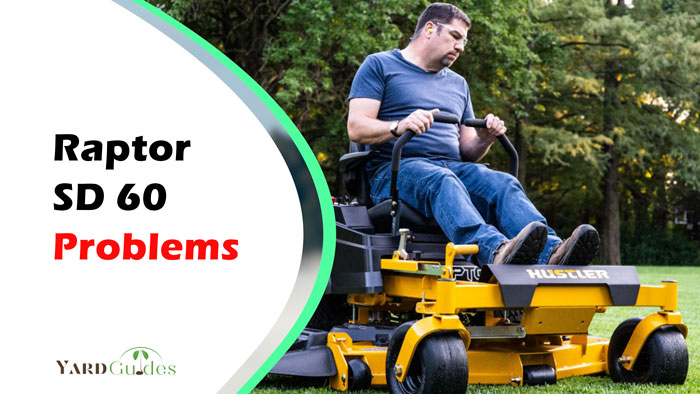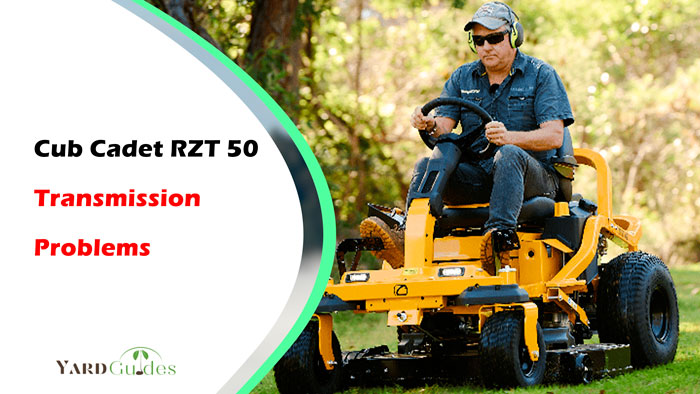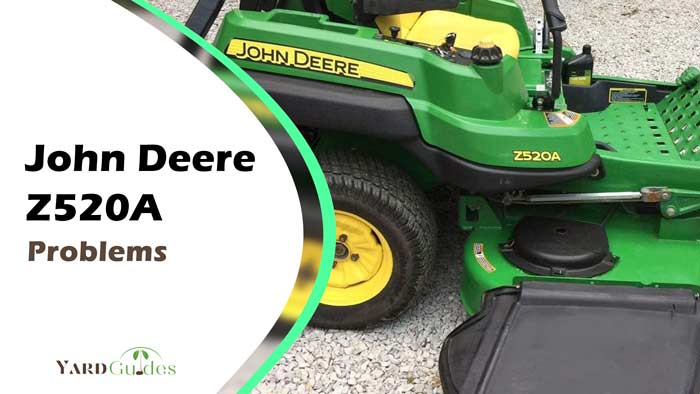With its 24HP Kawasaki FR730V engine, the Hustler Raptor SD 60” zero turn mower offers a top-notch residential mowing experience. Its robust transaxle makes light work of anything that a homeowner could ever need. Nonetheless, this mower does come with a few minor drawbacks.
So, what are the most common Raptor SD 60 problems? Drive belt failure is the most prevalent issue in the Raptor SD 60. Other problems include abnormal vibrations, blades failing to engage, uneven cutting height, and operating in one direction. In addition, you may experience engine starting issues or failure to keep running.
We will discuss the six most common problems with the Raptor SD 60 and how to fix them. Keep reading to learn more about these common issues and how to troubleshoot them!
Raptor SD 60 Problems & Solutions Chart
A well-executed preventative maintenance routine outlined in the Maintenance Manual can greatly reduce the risk of operating issues with the Raptor SD 60 mower. However, if difficulties do arise, this chart offers possible causes and potential solutions.
| Problems | Solutions |
| 1. Drive belt failure | Clean and re-install (for jammed belt) Replace (for melted or broken belt problem) Tighten tension nuts and bolts (for loose belt) Take to the service point (if the belt comes off for no reason) |
| 2. Engine failure to start or keep running | Use the right gasoline Check the fuel level and fill it up Remove and clean the air filter Clean and tighten the spark plug |
| 3. Abnormal vibrations | Tighten engine and blade mounting bolts Tighten or replace the spindle bearing Install new cutting blades (for unbalanced blades) |
| 4. Operating/veering on one side | Adjust and tighten the linkage Inflate the tires evenly |
| 5. Uneven cutting height | Sharpen the blades Install new blades (if bent) Level the deck Adjust the anti-scalp wheel Clean the underside of the deck Inflate tires evenly |
| 6. Cutting blade won’t engage | Check the clutch for damage or wear Replace the deck drive belt |
1. Drive Belt Problems
A loose, broken, melted, or jammed drive belt can happen to the Raptor SD 60 mowers. Several factors can cause drive belt problems, including-
- Overloading: If the mower is being used to cut excessively thick or high grass, it can cause the drive belt to break.
- Misalignment: The drive belt can become loose or come off if the pulleys are misaligned or damaged.
- Friction: If the drive belt rubs against other parts of the mower, it can cause the belt to melt.
- Poor maintenance: A lack of regular maintenance, such as lubricating the pulleys and cleaning debris from the deck, can cause the belt to become jammed or come off.
Solution
To resolve these problems, you may need to perform maintenance on your mower. These include replacing the belt if worn or broken, tightening the loose belt, and lubricating the pulleys. Raptor SD 60 pump drive belt typically lasts up to 2 years.
Also, you may want to contact your Hustler dealership if the belt drive comes off for no reason. This is often the case with new machines due to inappropriate design. However, if you feel confident and have some knowledge, you can refer to the Raptor SD pump belt diagram for a possible fix.
2. Engine Failure To Start/Keep Running
The engine may fail to start or may start then die for the following reasons:
- Plugged fuel line or low fuel level
- Incorrect fuel type
- Clogged fuel filter
- Faulty spark plug
- Malfunctioning choke
Solution
- Check if there is enough fuel in the tank. If the fuel level is low, fill the tank with fresh fuel. Use the correct fuel type for Hustler Raptor SD 60. Use regular unleaded gasoline with an 87-octane rating or higher.
- A dirty or worn-out spark plug can cause the engine to fail to start. Clean or replace your spark plug as needed.
- A dirty air filter can clog the engine and cause it to fail to start or keep running. Clean or replace the air filter as needed. A clogged or leaky fuel line can prevent fuel from reaching the engine. Inspect the fuel line and replace it as needed.
- If the choke is not functioning properly, the engine may not start or keep running. Adjust the choke or replace it as needed.
3. Abnormal Vibrations
It’s not uncommon for Hustler Raptor SD 60 mowers to experience unusual vibrations. There are a few common causes that you should check, including:
- Loose mounting bolts: If the mounting bolts that hold the engine, deck, or blades are loose, the machine will vibrate excessively.
- Worn-out spindle bearings: Spindle bearings help to keep the blade assembly in place and prevent it from wobbling. If the spindle bearings are worn out, they will cause excessive vibrations
- Damaged/loose pulleys: Pulleys help to transfer power from the engine to the blade assembly. If the pulleys are loose or damaged, they will cause excessive vibrations
- Unbalanced cutting blade: If the blade is not balanced, it can cause excessive vibrations that can damage the engine and other components.
Solution
- Tighten all the bolts and nuts to the specified torque settings (118 ft-lbs). If any of the bolts are damaged, you need to replace them with new ones.
- Remove the blade and balance it with a blade balancing tool. If the blade is too damaged, you need to replace it with a new one.
- Replace the spindle bearings with new ones or tighten to specified torque (118 ft-lbs).
- Tighten the pulleys or replace them with new ones.
4. Operating/Veering On One Side
Reasons that might cause your mower to veer or operate in one direction include-
- Improperly inflated tires: Tires that are under-inflated or over-inflated can cause the mower to pull to one side.
- Loose steering linkage: If the steering linkage is loose, it may cause the mower to turn or drift in one direction.
- Bent mower deck: If the mower deck is bent, it can cause the mower to cut unevenly, resulting in a pull in one direction.
- Worn or damaged spindle assembly: If the spindle assembly is worn or damaged, it can affect the cutting performance and cause the mower to veer in one direction.
Solution
- Check the bolts and nuts that secure the steering mechanism’s linkage and tighten any loose.
- Check the tire pressure and adjust it to the recommended level. The front and drive wheels’ recommended pressure is 8–12 psi (55–83 KPa).
- Use a level to check the deck and make any necessary adjustments to level it.
- Replace the spindle assembly with a new one to ensure proper operation.
Check out this video for a comprehensive guide on veering adjustment on a Raptor SD mower.
5. Uneven Cutting Height
Causes for uneven cutting height include-
- Dull cutting blades: A dull blade tears the grass rather than cutting it cleanly, which can result in an uneven cut and irregular growth patterns. According to horticulture specialist Ward Upham, you should sharpen the cutting blade after each 10 hours of use under normal conditions.
- Benting cutting blades: Bent blades will affect the balance of the mower and can cause uneven distribution of weight and pressure. This can lead to an uneven cut, as one blade may cut deeper into the grass than the other.
- Uneven cutting deck: If the deck is not level, it will cause the blades to cut at different heights. This can result in an uneven cut and can also cause damage to the blades, the deck, and the engine.
- Improper tire inflation: When the tires are not inflated to the proper pressure, they can cause the mower deck to be uneven and tilt to one side, resulting in an uneven cutting height.
- Incorrect anti-scalp wheel adjustment: The anti-scalp wheel helps to maintain an even cutting height by preventing the mower deck from scalping the grass. Too high an anti-scalp wheel might elevate the mower deck and cause uneven cuts. However, if the anti-scalp wheel is too low, it may not support the mower deck, resulting in uneven cuts again.
According to the University Of California Division of Agriculture and Natural Resources, no single mowing height is best for all turfgrasses. Instead, you should set the mower differently for each grass.
Solution
- Regularly sharpen or replace dull blades
- Regularly inspect and replace any damaged or bent blades
- Periodically check the level of the deck and make adjustments as necessary
- Regularly check the tire pressure and maintain the proper inflation level
- Adjust the anti-scalp wheel to the correct height to ensure even and consistent cutting results.
Refer to the table for the correct height settings of different grass types.
| Grass Type | Height Setting (Inches) |
| Bentgrass | 0.5-1 |
| Bermudagrass(hybrid) | 0.5-1 |
| Bermudagrass(common) | 1-1.5 |
| Perennial ryegrass | 1.5-2.5 |
| Tall fescue | 1.5-3 |
| Zoysiagrass | 0.5-1.5 |
| Buffalograss | 1-2 |
| Kikuyugrass | 1-1.5 |
| St. Augustinegrass | 1-2 |
| Kentucky bluegrass | 1.5-2.5 |
6. The Cutting Blade Won’t Engage
There are several reasons why a mower blade might not engage. A few of the most recurrent ones include:
- Drive belt problems: If the drive belt that connects the engine to the blades is loose or damaged, the blades may not engage.
- Clutch problems: If the PTO clutch that controls the engagement of the blades is damaged or worn, the blades may not engage.
Solution
First, inspect the blade and make sure it is properly attached to the mower and secure. If it appears loose or not attached, secure the blade back into place and try again.
Next, you’ll want to ensure that the belt connecting the engine to the blade is not worn or broken. If it appears damaged, replace it. You can also check to ensure that the drive cable is adjusted properly so it will move the blade when engaged.
If all of these appear to be in working order and the blade still won’t engage, then the issue may be with the electric clutch. The most typical causes of clutch failure are a lack of power supply, the wearing out of the clutch, or a defect in the clutch solenoid. Refer to this clutch not engaging the troubleshooting table for potential causes and corrective action.
Conclusion
The Raptor SD 60 lawn mower is a reliable and high-performing machine. But like any other lawn mower, it is not immune to problems. Common Raptor SD 60 problems range from engine issues, drive belt failure, abnormal vibrations, blades failing to engage, operating on one side, to uneven cutting height.
By properly maintaining your Raptor SD 60, you can avoid many of the common problems that users report. If the above steps don’t resolve the issue, it may be necessary to take the mower to a professional for further evaluation and repair.



